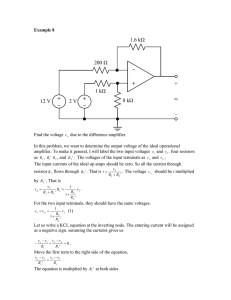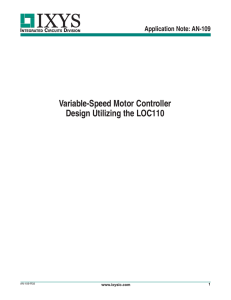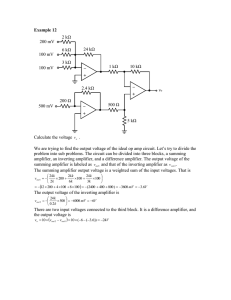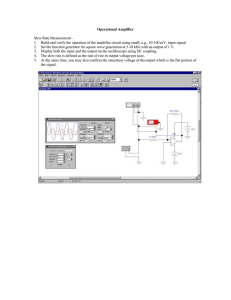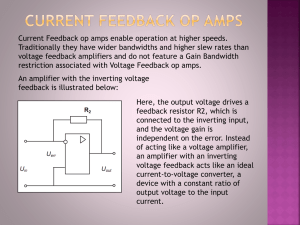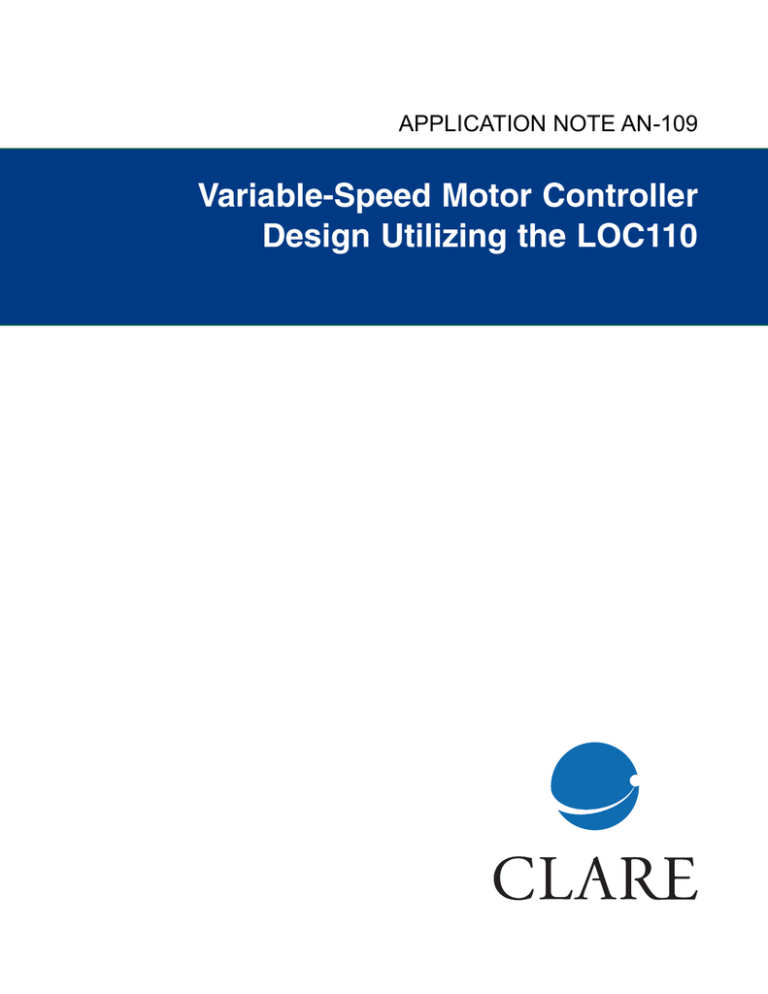
APPLICATION NOTE AN-109
Variable-Speed Motor Controller
Design Utilizing the LOC110
AN-109
Variable-Speed Motor Controller Design Utilizing the LOC110
The Application
Variable speed controllers regulate the speed and/or torque of asynchronous motors. Depending on the application, there are controllers from a few hundred Watts up to several hundred kWatts. These speed controllers
must conform to international standards and operate in industrial environments which are subject to high-energy overvoltages (surges), phase failure, overvoltages, undervoltages and supplies with high levels of noise
interference. It is in this type of environment that the LOC110 linear optocoupler from Clare excels. The
LOC110 is a linear optocoupler that provides 3750VRMS input/output isolation with a high CMRR and high noise
rejection ratio.
The Circuit
In the photovoltaic mode (figure 1) it is possible to get up to 12 bits resolution from the voltages you want to
monitor on your attached microcomputer or personal computer, which can be remote. The output voltages, of
course, are completely isolated from the mains.
When we look at figure 1, L1, L2 and L3 are the incoming line voltages up to 240 VRMS referred to the N (neutral) wire. These line voltages are the same for the upper and the lower circuit. (They are only separated for
better understanding of the circuit).
DIFFERENTIAL
AMPLIFIER
L1
L2
R2
L3
R1
VA
VA« R3
VCC1
VCC1
Ð
R7
+
R5
VA««
Ð
+
R4
BRIDGE/RECTIFIER
ISOLATION
AMPLIFIER
VCC1
N
R6
LOC110
1
8
2
7
3
6
Ð
5
+
4
VCC2
µPC
CONTROL
VOUT
L VP«
VP
L1
L2
L3
DIFFERENTIAL
AMPLIFIER
C
700V
M
3~
VCC1
R1
Ð
R3
BRIDGE/RECTIFIER
N
R5
+
CONVERTER
3-20 kHz P.W.M.
ISOLATION
AMPLIFIER
VCC1
R2
+
Ð
R4
R6
LOC110
R7
1
8
2
7
3
6
Ð
5
+
4
VCC2
Figure 1
The upper part monitors the line
voltages and the (absence of) phases.
The line voltages are rectified with a bridge (figure 2). The high voltage between VA´ and VA is converted to a
lower voltage with a differential (instrumentation) amplifier. The difference in voltage between VA´ and VA is
590VPEAK.
The output of the differential amplifier is found to be:
VA "
=
R2
R2
¥ 1 +
¥ VA' −
+ R4
R1
R1
R4
R3
¥ VA
if , R4 = R1, then it follows VA” =
R2
R3 R2
R1•(VA’-VA).
2
www.clare.com
Rev. 1
AN-109
Voltage Waveform VA, VA´
Referred to Neutral Wire
400
300
Voltage (V)
200
100
VA´
0
-100
-200
VA
-300
-400
0
2
4
6
8
10
12
14
16
18
20
Time (ms)
Figure 2
In our example (figure 3) we used 1MΩ for R1 and 15KΩ for R2.
Voltage VA´´ goes to the isolation amplifier (figure 4).
The isolation amplifier is configured in the photovoltaic mode. Whenever you need a bandwidth not greater
than 40kHz this is always the best configuration. This is mainly due to the fact that there are no dark currents
in this mode, since there is no external power source connected. In the photovoltaic mode, the LOC110 phototransistors act as current generators. The LED flux is incident on the servo phototransistor which starts current I1 to flow from the op amp inverting input through the phototransistor. This servo photocurrent generated
is linearly proportional to VA´´, I1=VA´´/R5 in order to keep the voltage on the inverting input equal to zero. The
flux form the LED is also incident on the output phototransistor which causes a current I2 to flow from the inverting input of the output op amp through the phototransistor. As I2 is pulled from the inverting node, the output of
the amplifier begins to go high until a current equal in magnitude to I2 is injected into the inverting node of the
amplifier. Since this current I2 flows through R2 an output voltage is developed such that VOUT = I2´•R6. VOUT is
also equal to VA´´•K3•R6/R5. Depending on the bin number (A to J) you receive, an LOC has a K3 varying from
0.55 to 1.426. K3 is the transfer gain K2/K1 where K1 is the servo gain I1/IF and K2 is the forward gain and IF
is the LED current flowing.
The lower part of the circuit (fig. 1) monitors the power bus voltage (about 600 VDC).
The line voltages are again rectified, but instead of a few mA’s, currents up to several hundreds of Amperes
are flowing. The ripple of voltage VP is rejected through the LC low pass filter. The voltage VP´ is the actual
power bus voltage. The zener diode is used to protect the capacitor from overvoltages when the machine suddenly reduces speed (brakes). The circuit after the zener diode represents the control circuit for the Pulse
Width Modulation with modulation frequencies mostly used somewhere between 3 and 20 kHz.
VCC1
Voltage Waveform VA´´
Referred to Neutral Wire
Voltage (V)
8
VA««
6
R5
+
IF
Ð
I1
4
2
0
0
2
4
6
8
I2«
VCC1
10
R7
LOC110
R6
1
8
2
7
3
6
4
5
VCC2
I2
Ð
VOUT
+
10 12 14 16 18 20
Time (ms)
Figure 4
Figure 3
Rev. 1
www.clare.com
3
For additional information please visit our website at: www.clare.com
Clare, Inc. makes no representations or warranties with respect to the accuracy or completeness of the contents of this publication and reserves the right to make changes to specifications and product descriptions
at any time without notice. Neither circuit patent licenses nor indemnity are expressed or implied. Except as set forth in Clare’s Standard Terms and Conditions of Sale, Clare, Inc. assumes no liability whatsoever, and
disclaims any express or implied warranty, relating to its products including, but not limited to, the implied warranty of merchantability, fitness for a particular purpose, or infringement of any intellectual property right.
The products described in this document are not designed, intended, authorized or warranted for use as components in systems intended for surgical implant into the body, or in other applications intended to support or sustain life, or where malfunction of Clare’s product may result in direct physical harm, injury, or death to a person or severe property or environmental damage. Clare, Inc. reserves the right to discontinue or
make changes to its products at any time without notice.
Specification: AN-109-R1.0
©Copyright 2002, Clare, Inc.
All rights reserved. Printed in USA.
6/25/02

